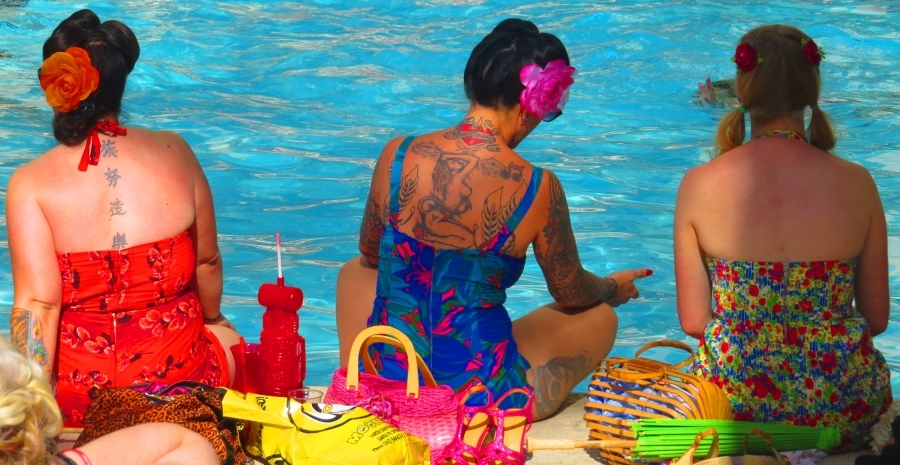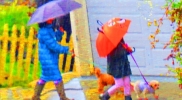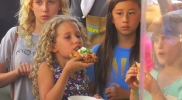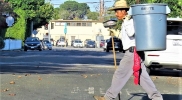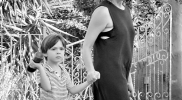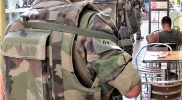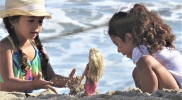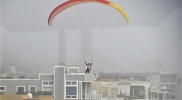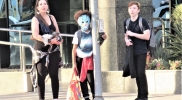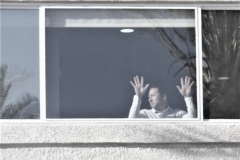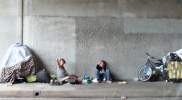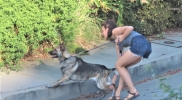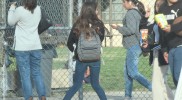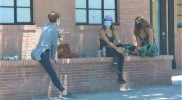|
|
Best Trivia - Photography
|
Favorite Trivia – PHOTOGRAPHY
|
| A well-known photographer was attending a dinner party in his honor. The hostess said, “You take such great pictures, you must have really good cameras.” At the end of the dinner as dishes were being cleared away, he could not resist saying to her, “You cooked a wonderful dinner. You must have really good pots and pans.”
Complete Digital Video Guide – Bob Brandon
|
| “People ask, ‘What camera do you use?’ I say, ‘You don’t ask a writer what typewriter he uses.'”
Man Ray
|
| “I can’t see without my camera.”
Patty Martino Alspaugh
|
| “When cameras became smaller a photographer’s world became a whole lot bigger. Armed with their discreet magic boxes, photographers began tiptoeing through city streets, recording an alternate reality of beautifully ephemeral human moments.”
Read This If You Want to Take Great Photographs Of People – Henry Carroll
|
|
“It was perhaps André Kertész who first demonstrated the enormous photographic richness of the street. For a generation of photographers since, the street has been the true living theater, where slapstick and tragedy and all manner of sideshows have elbowed each other for performing room, and all of it accessible and free. Had the photographer written the script and directed the action he could not have done so well.”
Looking at Photographs – John Szarkoewski
|
| “…George Bernard Shaw eulogizes ‘artist photographer’ Alvin Langdon Coburn on the grounds that he was ‘free of that clumsy tool—the human hand.'”
The Secret Paris of the 30’s – Brassaï
|
|
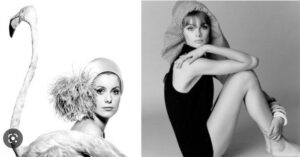
“I never considered myself a fashion photographer. I’ve never really been interested in fashion. The reason I did fashion was that I liked what was in the frocks.”
David Bailey – 50 Contemporary Photographers You Should Know (Florian Heine and Brad Finger)
|
| “If you want a picture, you get that picture, under all circumstances.”
Peter Magubane
|
| “A camera is a tool for learning how to see without a camera.”
Dorothea Lange
|
| “Photography is creative—it is an artistic tool—and it sees broadly but it cannot entirely escape its inherent function to record.”
“Street photographers respond to the absurdities of life and humour inevitably surfaces.”
“The combination of patience and luck is at the heart of street photography.”
“Quite possibly the potential for luck increases at events and this is why they are the life-blood for street photographers.”
“The ethos of street photography is to be free of obligations.”
The Street Photographer’s Manual – David Gibson
|
| “No guidebooks between me and an experience. I never rent headphones in museums, I buy guidebooks only after the fact so I can recall things, I can’t bear sticking a camera between me and an object, person, a scene. Freshness of encounter—I insist!
Molly Peacock – The Paper Garden: Mrs. Delany [Begins Her Life’s Work] at 72
|
| “While many adhered to Robert Frank’s dictum that ‘black and white are the colors of photography,’ there was also a financial reason; namely that because of the material-intensive nature of photography, the high costs of developing color film and prints meant that black and white was simply more affordable.”
50 Contemporary Photographers You Should Know (Florian Heine and Brad Finger)
|
| “The personality of the photographer is really more important than his technical genius.”
Lee Miller
|
| “When I was twelve I realized that photographs were ruining my memory. I’d study the photos from an event and gradually forget everything that had happened between the shutter openings. I couldn’t tolerate so much lost memory, and I didn’t want to spectate my life through a viewfinder, so I stopped taking photographs. All the snapshots of my life for the next twenty years were shot by someone else. There aren’t many, but there are enough.”
Ongoingness: The End of a Diary – Sarah Manguso
|
| “Photographing the work of great painters during his (Manuel Alvarez Bravo’s) early days ‘taught me attitudes, the reality and technique of art . . . the personal selection of details,’ Bravo said in an interview around the time of his 1992 show at the Getty. ‘It gave me a concentration in different ways of seeing and thinking.'”
Los Angeles Times, January 28, 2010 – Mike Boehm
|
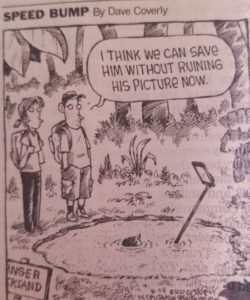 |
|
Blessed be the inventor of photography! I set him above even the inventor of chloroform. It has given more positive pleasure to poor suffering humanity than anything that has cast up in my time—this art by which even the poor can possess themselves of tolerable likenesses of their absent dear ones. I have often gone into my own room in the devil’s own humour, and my eye resting by chance on one of my photographs of long-ago places and people, a crowd of sad, gentle thoughts has rushed into my heart.”
Jane Welsh Carlyle, Letter, 1859 (Christopher Morley’s Book of Days for 1931 [August 27])
|
|
Brassaï (née Gyula Halász), known for his nocturnal photography of the underside of Paris in the 1920s and 1930s, discusses how he would knock on doors in the middle of the night asking the occupants to let him take pictures out their windows. “One winter’s night, having spotted a seventh-story attic window in a decaying house across from the church of Satin-Séverin, I climbed the dark stairs . . . A man and a woman in nightgowns were standing in the middle of the small room . . .
‘What do you want?’ the man asked.
‘I’d like to see Paris from your window. You’d be doing me a great favor,’ Brassaï said.
‘I’m glad I can still do a favor for someone,’ the man replied. ‘Go on. look . . . we don’t know what it’s like. We’re both blind.'”
The Secret Paris of the 30’s – Brassaï
|
|
“Many photographers were concerned with what the poet Percy Bysshe Shelley called ‘startl[ing] the reader from the trance of ordinary life.'”
Mary Warner Marion – Photographic Visionaries
|
|
“Founded in Paris in 1924 [Surrealism] by poet and writer André Breton, the movement was launched with a Surrealist Manifesto that championed the reclamation of childhood ways of seeing, noting ‘at an early age children are weaned on the marvelous.’
“Mirrors have often been used as devices to suggest parallel realities in literature . . . Alice [Through the Looking Glass] finds that the ‘looking glass’ world is full of riddles that make her question the rules and structures of the ‘normal’ world she left behind. This jolt from complacency is at the heart of Surrealism, and the power of the surreal to provoke a reconsideration of the limits of normality has proved compelling throughout the twentieth century.”
Eleanor Clayton – Viviane Sassen: Hot Mirror
|
|
“A way of certifying experience, taking photographs is also a way of refusing it—by limiting experience to a search for the photogenic, by converting experience into an image, a souvenir. Travel becomes a strategy for accumulating photographs. The very activity of taking pictures is soothing, and assuages general feelings of disorientation that are likely to to be exacerbated by travel. Most tourists feel compelled to put the camera between themselves and whatever is remarkable that they encounter.”
Susan Sontag – Vivian Maier, Pamela Bannos
|
|
“. . . it must be said that Cartier-Bresson’s photographs are revered by other photographers because they are beautiful. They possess grace, balance, surprise, economy, tension, and visual wit . . .”
Looking at Photographs – John Szarkowski
|
| “Today, [Helen] Levitt’s early work has shaken off its 1950s sugar coating, in part because of her dynamic colour work . . . The range of her colour work is likely never to be known, because most of her work from the 1960s was stolen in a burglary at her home.”
Mary Warner Marion – Photographic Visionaries
|
|
“Koudelka is the true poet of photography and represents, as it were, the ideal of street photography, which unites more than any other genre of photography the essential elements of the art: observation, imagination, an attentive eye, and a feel for people and places.”
50 Contemporary Photographers You Should Know (Florian Heine and Brad Finger)
|
|
“It was my father who taught me the physics of photography. When I was a boy he explained to me the power of light in the making of a photograph. He held a magnifying glass between the sun and a leaf and set the leaf on fire. The next day, as an experiment, I taped a negative of my sister onto my skin and spent the day at Atlantic Beach. That night, when I peeled the negative off, there was my sister sunburned onto my shoulder.”
Richard Avedon
|
|

“The classic anecdote about Avedon getting what he wanted from a sitter is the one about him going to photograph the Duke and Duchess of Windsor. They were great animal lovers. They doted on their pugs. Avedon set up the portrait, talking all the while, and just before he took the picture he told them a story, completely untrue, about how on the way to the sitting his taxi had run over a little dog. That broke their composure. He got the famous portrait of them looking anguished.”
Annie Leibovitz – At Work
|
|
“I’ve always loved the element of chance and the spontaneity of street photography. The idea that you can leave the house with nothing one morning, and by the end of the day have a photo that will be with you forever excites and drives me.”
Jesse Marlow (Street Photography Now – Sophie Howarth and Stephen McLaren)
|
|
“The difference between a fiction writer and a non-fiction writer is likened to the difference between a painter and a photographer: A painter captures the unreality of life; a photographer the reality.”
Patty Martino Alspaugh
|
|
“The Teddy boys had a ‘propensity to peacock,’ as Steele-Perkins puts it. The challenge, then, was to balance genuinely candid moments with more staged scenes in which the Teddy boys overtly posed for the photographer . . . Rules and codes, behavior and interaction are seen through a continuum of lived events, sequences of life on the fringes: aging Teds, young Teds, drunk Teds, dancing Teds, smoking Teds, sneering Teds, snogging Teds, tongue-tied Teds, rockabilly Teds, jiving Teds, fighting Teds, knife-welding Teds, urinating Teds.”
Tim Clark – Another Kind of Life: Photography on the Margins – ed. by Alona Pardo
|
|
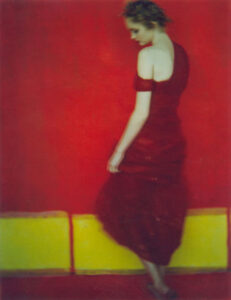 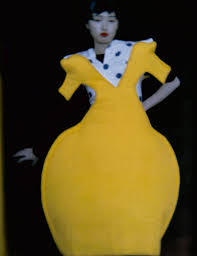
“A fashion photographer I am and remain, I can say that for certain, but I also take photographs without any particular aim in mind, photographs of everything and nothing, things that look good to me or that don’t look good.”
Sarah Moon
|
|
“Parr does not photograph the exotic but rather the banal of the everyday, in all its outlandishness. ‘This discrepancy between the world of advertising and the real world around us is the photographer’s playground.'”
Martin Parr – 50 Contemporary Photographers You Should Know (Florian Heine and Brad Finger)
|
| “Dickey Chapelle died on patrol in Vietnam, when a mortar exploded while she was not wearing a flak jacket. She was the first war correspondent killed in the Vietnam War.”
Mary Warner Marion – Photographic Visionaries
|
|
“While photographs may not lie, liars may photograph.”
Lewis Hine
|
|
“[Nacho] López frequently posed his subjects and, indeed, created scenarios for shoots, in the manner of the film director he would become. He hired an attractive female model to walk populated streets while he recorded the expressions of men as they watched her. In another gag, he had a man walk through crowded streets carrying a female mannequin, setting it down occasionally, while López photographed.”
Mary Warner Marion – Photographic Visionaries
|
|
Walker Evans approach to photography was simple: “Stare. It is a way to educate your eye, and more. Stare, pry, listen, eavesdrop.”
|
|
“Dora Kallmus, who later called herself Madame d’Ora, could not find any postcards during her holiday in the south of France, whereupon she simply bought a camera and photographed views to use as postcards herself. Then she came to the conclusion that she wanted to become a photographer.”
Boris Friedewald – Women Photographers (Introduction)
|
|
“In 1886, painter Thomas Eakins was forced to resign as teacher of figure painting at the Pennsylvania Academy because he had asked students to pose for a life class and had removed the loincloth from a male model.”
Charis Wilson – Edward Weston Nudes
|
|
“I used to think I couldn’t lose anyone if I photographed them enough . . . In fact, they show me how much I’ve lost.”
Nan Goldin
|
|
“His [Weegee’s] nickname has two sources, one of which is ‘squeegee boy,’ a title referring to the lowly job of running a squeegee over a wet photographic print to get the water off, which Weegee may have done in his early jobs. The second source, and Weegee’s favourite, was a reference to the Ouija board, or ‘spirit board’—a device popular at the the time for trying to receive messages from the spirit world. It was said that Weegee arrived so quickly at the scene of a murder or crime, it was as if he had a Ouija board. In fact, he had a police radio and other equipment in the back of his car.”
Mary Warner Marion – Photographic Visionaries
|
|
“Things happen in front of you. That’s perhaps the most wonderful and mysterious aspect of photography. It seemed like you just had to decide when and where to aim the camera.”
Annie Leibovitz – At Work
|
|
“I am hired by the film studio as what is called a special stills photographer. A special stills photographer works on a film set for any number of days or weeks and makes photographs which are used for publicity or advertising.”
Mary Ellen Mark – Seen Behind The Scene: Forty Years of Photographing on Set
|
|
“. . . as I clicked through the unedited raw work I kept getting glimpses of [Vivian] Maier’s insights and timing; great, positive attitude; way of framing; courage of her convictions about how close she was willing to go; genuine curiosity; and undeniable, humanistic warmth, irony, and humor, all of which produced an overall sense of a coherent life view.” [Maier died when she was 83 years old.]
Joel Meyerowitz, Forward to Vivian Maier: The Color Work
|
|
“In Ukraine, Boris Mikhailov paid homeless people to pose, some with their pants down, their scars exposed, their toothless mouths on show.”
Vicki Goldberg – Light Matters: Writings on Photography
|
|
“I’m always drawn to images which raise questions rather than give answers.”
Viviane Sassen – Viviane Sassen: Hot Mirror
|
|
“Whereas writers have the benefit of a vast and descriptive language, photographers are bound by the confines of the still image to embody a location’s essence. Instead of carefully chosen adjectives, we rely on timing, color, texture, energy, movement, line, shadow, and subject to give the viewer a holistic sense of a location.”
The Enthusiasts Guide to Travel Photography: 55 Photogenic Principles You Need to Know – Jordana Wright
|
|
“I could never have imagined anything so remarkable [regarding some of his own photographs]. This is one of the true gifts of the world to a photographer.”
Alex Webb
|
|
Henri Cartier-Bresson regarding ‘The Decisive Moment’:
“. . . recording in a fraction of a second the emotion of the subject, and the beauty of the form.”
“I prowled the streets all day, feeling very strung-up and ready to pounce, determined to ‘trap’ life—to preserve life in the act of living.”
“Composition must be one of our constant preoccupations, but at the moment of shooting it can stem only from our intuition, for we are out to capture the fugitive moment.”
Henri Cartier-Bresson – The Mind’s Eye: Writings on Photography and Photographers
|
| “Later, he [Brassaï] wrote that the contemporary world had a deep hunger ‘to capture life at its source, in its immediacy, and without the intermediary of the artist, whether that artist is brilliant or boring. . . Even the most mediocre photographs contain something unique and irreplaceable, something that no Rembrandt, Leonardo, or Picasso—no masterpiece and no artist, living or dead—can attain or equal or replace.'”
Vicki Goldberg – Light Matters: Writings on Photography
|
|
“For one of her first major assignments, in 1989, Ellen Von Unwerth [former fashion model] chose a young German model that reminded her of Brigitte Bardot: Claudia Schiffer. The resulting series of photos launched the meteoric rise of them both.”
50 Contemporary Photographers You Should Know (Florian Heine and Brad Finger)
|
|
“It is the eye that takes the picture, not the camera.”
Gisèle Freund
|
|
Why a photo is not great: “. . . although it has mystery, it lacks soul, character or depth; it is not a photograph to linger upon, to truly fire the imagination.”
David Gibson – 100 Great Street Photographs
|
|
“I don’t like to arrange things. If I stand in front of something, instead of arranging it, I arrange myself.”
Diane Arbus
|
|
“Speaking about a quality of Kertesz’s work that is not easily analyzed, Szarkowski states, ‘It is a sense of the sweetness of life, a free and childlike pleasure in the beauty of the world and the preciousness of sight.'”
John Szarkowski – Looking at Photographs
|
|
“Allow your own personality to feed into your portraits. Some prefer to prey on their unsuspecting subjects from afar—snipers. Others get closer and like to establish some kind of connection—undercover agents. Then there are those who dart in, shoot up close and make off—assassins.
Henry Carroll – Read This If You Want to Take Great Photographs Of People
|
|
“… if one wanted a purely photographic genealogy for her [Arbus], one would have to put on one side Weegee, who loved the extreme as she did, and Lisette Model. . . from whom she learned graphic drama and the importance of getting up close.”
Leo Rubinfien – Another Kind of Life: Photography on the Margins
|
|
“Bellocq had a secret life. After his death a collection of about one hundred plates was discovered in a drawer of his desk. The plates were portraits of New Orleans prostitutes, dating from about 1912. It is possible that the pictures were made as a commercial assignment, but this seems unlikely; they have about them a variety of conception and a sense of leisure in the making that identify them as work done for love. . . The prostitute portraits comprise the only fragment of Bellocq’s work to have survived.”
Looking at Photographs – John Szarkowski
|
| Discussing a photographer’s tenet to fill the frame: “A teacher of drawing once pointed out to his students, in trying to persuade them to use the whole sheet of paper, that a peanut in the bottom of a barrel was merely a spot, whereas a peanut in a penny matchbox was a piece of sculpture.”
Looking at Photographs – John Szarkowski
|
| “It is the photographer, not the camera, that is the instrument.”
Eve Arnold
|
| “When Ben Fong-Torres was writing a story on Ike and Tina Turner, I went alone to photograph them at their house. There were vats of white powder lying around. Cameras in all the rooms fed back to Ike’s room. There was a lot of stuff going on, but Ike was very friendly and I took my pictures and left. When I got back to the office I told Ben some of what I’d seen. I don’t think I told him everything, but he put some of the details in his piece. When it was published, I got a call: ‘Annie, this is Ike. How could you have done that? We have ways to take care of people like you.’ I decided that from then on the writer’s story was his story and my story was my story.”
Annie Leibovitz – At Work
|
| “Impressionism was a direct response from painting to the creation of photography. At the same time, the impressionists influenced all of art as we have it today, including photography. Pictorialism, the first art movement in photography, was a response to the Impressionists . . . The French painter Degas expresses how I feel: ‘Painting is not what you see but what you make others see (including yourself).'”
Claudio Edinger
|
| “…those who were less than enchanted by the new technology just as boldly voiced skepticism, poked fun, and even denounced the daguerreotype as the devil’s work: ‘To fix fleeting images is not only impossible, as has been demonstrated by very serious experiments in Germany, it is a sacrilege,’ thundered one writer in a German newspaper. ‘God has created man in HIS image and no human machine can capture the image of God. He would have to betray all his Eternal Principles to allow a Frenchman in Paris to unleash such a diabolical invention upon the world.'”
The Critical Image (Introduction) – ed. by Carol Squiers
|
| “Photographs aren’t good at telling stories. Stories require a beginning, middle, end. They require the progression of time. Photographs stop time.”
Alec Soth – 50 Contemporary Photographers You Should Know (Florian Heine and Brad Finger)
|
| Photography: “The mirror with a memory.”
Oliver Wendell Holmes
|
| “My theory is, the more pictures you take, the better you get. It’s like a sport. I never wait to get a particular shot because wonderful accidents can happen when you shoot a lot.”
Tina Barney
|
|
“Photography’s allure to the photographer: To capture a scene that otherwise would not be seen again.”
Patty Martino Alspaugh
|
| “Roland Barthes called a punctum the single errant detail in certain photographs that gives them their power.”
Colin Westerbeck, Vivian Maier: The Color Work
[Barthes twin concepts of interpreting a photograph (La Chambre Claire): studium denotes the cultural, linguistic, and political interpretation; punctum denotes the wounding, personally touching detail which establishes a direct relationship with the object or person within it] |
| “The important thing is the combination of intuition with discipline, because you have to be extremely aware and invisible at the same time. The eye has to be highly vigilant, capturing everything at once. I don’t know how to describe it. What the eye sees is a synthesis of who you are and all you have learned. This is what I would call the language of photography . . . The work of the photographer is then to synthesize, to take something ordinary and to create from it something that is strong and poetic.”
Graciela Iturbide in conversation with Fabienne Bradu – Conversations with Contemporary Photographers
|
|
“I press the button in order to see what I have seen.”
Sibylle Bergemann
|
|
“I have learned how to organize and direct large groups, but I would always rather photograph an individual. No group picture is going to have the power of an individual portrait.”
Annie Leibovitz – At Work
|
| “Luck is in the long run impartial; it will degrade many photographs by allowing small graceless errors in drawing or composition, but it will as often contribute an unforeseen detail or rendering that blesses the picture with the felicity of happy surprise. And whether good or bad, luck is the attentive photographer’s best teacher, for it defines what might be anticipated next time.”
Looking at Photographs – John Szarkowski
|
| “I am a voyeur! If a photographer says he is not a voyeur, he is an idiot!”
Helmut Newton Portraits
|
|
“Street photographers try to capture telling images from the unpredictable flow of pedestrian life on city streets. They look for fleeting interactions, for moments of anonymous drama, for style in gestures and clothing. The work is done unobtrusively, usually from within the crowd, with a small hand-held camera. Timing and good reflexes are crucial. A street photographer has to be willing to walk for hours on end, and also to loiter in promising spots without being obvious.”
Allan Sekula – Vivian Maier, Pamela Bannos
|
|
“The Daguerrotype. I went this morning by invitation of M. Francois Gouraud to see a collection of the views made by the wonderful process lately discovered in France by M. Daguerre… The reflection of surrounding images created by a camera obscura upon a plate of copper, plated with silver and prepared with some chemical substance, is not only distinctly delineated, but left upon the plate so prepared and there remains forever. Every object, however minute, is a perfect transcript of the thing itself; the hair of the human head, the gravel on the roadside, the texture of a silk curtain, or the shadow of the smallest leaf reflected upon the wall, are all imprinted as carefully as nature or art has created them in the objects transferred; and those things which are invisible to the naked eye are rendered apparent by the help of a magnifying glass… How greatly ashamed of their ignorance the by-gone generations of mankind ought to be.” [December 4, 1839]
Diary of Philip Hone 1828-1851
|
|
“Weston [Edward] had an amazing number of girlfriends, all good-looking and all more than happy to take their clothes off for him. He was one of those men who, as they say, got more ass than a toilet seat.”
The Ongoing Moment – Geoff Dyer
|
|
“I photograph to see what the world looks like in photographs.”
Garry Winogrand
|
|
“She [Vivian Maier] relied more on making the subjects she offered to photograph feel flattered by her attention to them, even when her real interest in taking the picture was something she found odd about them. . . thus could a posed portrait turn into the classic visual ‘gotcha’ characteristic of street photography.”
Colin Westerbeck, Introduction, Vivian Maier: The Color Work
|
|
“Street photographers have an instinct. They are pulled by who is out there or pushed to others. We all have our inner casting director. This one here you don’t care about. This one has dignity, tragedy, bearing. Something speaks to us. It’s like following a divining rod.”
Joel Meyerowitz
|
|
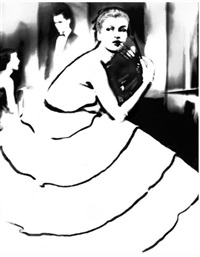 
“Lillian Bassman was a fashion photographer (married to photographer Paul Himmel), who gave up photography in her 40’s and stuffed the negatives produced over four decades into a few sacks and put them out with the trash. Fifteen years later a neighbor rang her doorbell; she had rescued the negatives and kept them. When Bassman saw her negatives again her pleasure in photography and fashion returned. . . In the mid-1990’s Bassman began a second career as a fashion photographer, working for such clients as John Galliano, Vogue, and The New York Times.”
Boris Friedewald – Women Photographers: From Julia Margaret Cameron to Cindy Sherman
|
|
“Time goes on, things change from moment to moment, and a photo is all that remains of the moment past.”
E.L. Doctorow – The March
|
|

“In March 1936, Dorothea Lange was driving through Nipomo, California, nearing the end of a month on the road taking photographs for the Farm Security Administration, when she encountered a sign, Pea-Pickers Camp. ‘Having well convinced myself for 20 miles that I could continue on,’ Lange said, ‘I did the opposite. Almost without realizing what I was doing I made a U-turn off the highway at that sign.’ Entering the camp, Lange encountered 36-year old Florence Thompson, a widow with six children. Lange spoke to Thompson for about 10 minutes and took 5 exposures. The iconic image ‘Migrant Mother,’ a photo Lange took of Thompson with 3 of her 6 children, became the defining image of the great depression.”
Patrick McGreevy – Los Angeles Times, March 17, 2016
|
|
“In the past decade this new generation of photographers has redirected the technique and aesthetic of documentary photography to more personal ends. Their aim has been not to reform life but to know it, not to persuade but to understand. The world, in spite of its terrors, is approached as the ultimate source of wonder and fascination, not less precious for being irrational and incoherent.”
John Szarkowski referring to his curated show in 1967 at the Museum of Modern Art, New Documents
|
|
“The influence of photography on Impressionism would be easier to assess had it not been the practice of the time to use photographs clandestinely.”
“Aaron Scharf conducted extensive research into the relationship of painting and photography in that period (Impressionism) . . . Scharf’s investigations reveal, indeed, that actual photographs were often used by the Impressionists as a basis for their compositions.”
Phoebe Pool – Impressionism
|
|
In 1839, two inventors, Louis-Jacques-Mandé Daguerre in France and William Henry Fox Talbot in England, created processes to produce pictures through the action of light. Both processes employed a camera obscura, a box or chamber with a tiny hole through which light casts an inverted image of what is outside. They both discovered that a surface treated with SILVER IODIDE inserted into a camera obscura could record the projected image automatically. Chemical treatment of the surface after removal made it no longer reactive to light.
But here is where they differed:
Daguerre’s process, which he called a daguerreotype, produced a unique and highly detailed image on a polished METAL PLATE.
Talbot’s process, which he eventually termed the calotype (why not Talotype? me), produced a fuzzier but readily replicated image on PAPER. Although the images produced by both processes were, like mirror images, laterally reversed, the images Talbot produced also rendered light areas dark, and dark areas light. Exploiting the translucence of paper, he was able to re-reverse the ‘negative’ image in both respects by putting another sensitized piece of paper underneath the paper bearing the image and exposing the latter to light. This process, which yielded a ‘positive’ image, could be repeated to make multiple copies.
In 1851, the negative and positive images were refined to create clear images with great detail by using a glass plate in lieu of paper for the negative (wet-plate collodion negative) and by coating the paper for the positive with albumen and chlorides (albumen positive). These technological innovations facilitated the emergence of a photographic industry that trafficked in mass quantities.
Robin Kelsey – Photography and the Art of Chance
|
|
The introduction of DRY plates in 1880 radically changed the photographer’s methodology because they “could be purchased ready to use and held for weeks between exposure and development. The new process was incomparably easier and more convenient than the old one; more important, it changed the photographer’s philosophy of shooting, for he could now take risks. Once the wet-plate photographer had made his exposure, he was out of commission until that plate had been developed and a new one prepared; with dry plates, the photographer could stay with his subject, make a half-dozen exposures, and hope. Peception and exposure could now be virtually simultaneous so the camera stand was no longer necessary. Thus the dry plate spawned the hand camera, with which the photographer could move freely, changing his vantage point until the very instant of exposure.”
John Szarkowski – Looking at Photographs
|
|
The Graflex camera: “For the first fifty-odd years of photography, the photographer had to compose and focus his picture upside-down on a groundglass in the back of his camera, then insert the holder that held the sensitive plate. Once the plate was in the camera, the photographer was shooting blind, unable to change either his framing or his focusing. With the Graflex on the other hand, he saw his picture just as the camera would record it until the very instant that he pushed the trigger. This meant he could frame his subject boldly, to the very edges of the plate; he could change his angle of view at the last moment; he could focus selectively on the most important plane of his subject, allowing the nearer and farther planes to be recorded out of focus.”
John Szarkowski – Looking at Photographs
|
|
“The problem for a photographer who deals in sharp, unmanipulated images is that he cannot simplify a face, or generalize it into a type, as a painter or sculptor can. If the full face appears, the picture is inevitably the portrait of a particular individual and the expression of the face will dictate the viewer’s response to the body. If a photographer wants to make a nude, rather than a nude portrait, he has only three possible options: the face must be averted, minimized by distance, or excluded. . . Throughout Edward’s most important working years—the 1920s through the 1940s—the nude retained its sinful image. Postal regulations prohibited the depiction of pubic hair in photographs shipped by mail.”
Charis Wilson – Edward Weston Nudes
|
|
“Szarkowski recognized a unique attitude in his work [William Eggleston’s], observing that Eggleston’s images were not social documentary but closer to a diary. They ‘are simply present: clearly realized, precisely fixed, themselves, in the service of no extraneous roles.'”
Mary Warner Marion – Photographic Visionaries
|
|
“Steichen at thirty-nine has been at the vanguard of the twentieth-century controversy over Is photography art? Not satisfied with what he had done with the camera, he took to painting and made a success in that medium too. When he returned home after his service in World War I, he burned all of his paintings.”
Vanity Fair: Photographs Of An Age – ed. by Diana Edkins Richardson
|
|
“One of the most joyful things about photography—and one that keeps me going back for more—is when I take a photograph of one thing and am surprised by another!”
Patty Martino Alspaugh
|
|
“I am mesmerized by her work [Vivian Maier]. She is what photography is all about. You wait, you shoot, you learn, you shoot, you capture.”
An unnamed fan – Vivian Maier: Out of the Shadows, Richard Cahan & Michael Williams
|
|
“… the new medium of photography (1839) inserted both a visibly extended past and visibly extended future. . . Photography magnified life’s inherent poignancy, preserving the promise of childhood long after it was dashed, the loveliness of youthful good looks that age had long since stolen.”
Vicki Goldberg – Light Matters: Writings on Photographys
|
| “She [Vivian Maier] lasted less than a year with the family of Phil Donahue, who hired her to watch his four boys at their Winnetka home, just north of Wilmette. (The TV talk show host recalled that Maier photographed him at her interview.) Life was particularly chaotic for his family during the 1970s. He had just separated from his wife and moved his show to Chicago. His boys, three teenagers and a twelve-year-old, saw no reason that they should need daily direction. ‘The women who came into my life as nannies didn’t last too long,” he told Chicago magazine. ‘No matter who they were, the kids hated them. They were rent-a-mothers.’
“The Donahue boys especially disliked Maier. They disparaged the way she dressed (like Maria von Trapp in The Sound of Music), the way she muttered under her breath, and the way she put apricots on peanut butter sandwiches. They watched her leave the house on Pine Street in a black hat and black boots, taking odd photographs of trashcans and coffee cups. Their father had little more appreciation. ‘I once saw her taking a picture of the inside of a refuse can, like a public refuse can, and I thought, “Well, you know, they laughed at Picasso. Or how about Pollock? If he can drip this stuff, why shouldn’t she be able to do that. No one was too upset when she left, he recalled.'”
Vivian Maier: Out of the Shadows, Richard Cahan & Michael Williams
|
| “The camera is a kind of passport that annihilates moral boundaries and social inhibitions, freeing the photographer from any responsibility toward the people photographed. The whole point of photographing people is that you are not intervening in their lives, only visiting them. The photographer is a supertourist, an extension of the anthropologist, visiting natives and bringing back news of their exotic doings and strange gear.”
Susan Sontag (Photography After Photography – Abigail Solomon-Godeau)
|
| “Clouds have been tempting me again. Next to the recording of a fugitive expression, or revealing the pathology of some human being, is there anything more elusive to capture than cloud forms! And the Mexican clouds are so swift and ephemeral, one can hardly allow the thought, ‘Is this worth doing?’ or ‘Is this placed well?’—for an instant of delay and what was, is not!” [July 9, 1924]
Edward Weston, The Flame of Recognition: His photographs accompanied by excerpts from the Daybooks & Letters
|
| “The glorious new pepper Sonya brought has kept me keyed up all week and caused me to expose eight negatives—I’m not satisfied yet!. . . But the pepper is well worth all the time, money, effort. If peppers would not wither, I certainly would not have attempted this one when so preoccupied. I must get this one today; it is beginning to show signs of strain and tonight should grace a salad. It has been suggested that I am a cannibal to eat my models after a masterpiece. But I rather like the idea that they become a part of me, enrich my blood as well as my vision. Last night we finished my now famous squash, and had several of my bananas in a salad.” [August 1, 1030]
Edward Weston, The Flame of Recognition: His photographs accompanied by excerpts from the Daybooks & Letters
|
| “Whatever reasons, I enjoyed being nude; it felt natural to me. I got the same kind of pleasure from being free of clothing that many people get from being well dressed. This did not mean that I was satisfied with my appearance. My mother was always trying to correct my posture because I carried one shoulder lower, and to straighten out my walk because of my tendency to toe in. She had also convinced me that my hips were much too large. This kind of nurturing had made me self-conscious about my defects, but it hadn’t arrested my tendency toward exhibition. The Sunday for the sitting came [with Edward Weston], I would never in the world have admitted that this was the first time that I had posed in the nude; part of my psychological makeup in those days was the need to be always ahead of the game—to have already done everything. So when Edward pointed out the bathroom in the entrance hall where I could change into my bathrobe if I wanted, I just said, ‘Right here is fine,’ and peeled off my clothes while we went on talking. Once that was done, I felt perfectly comfortable, though regretful for the mutilation of a fresh appendix scar.”
Charis Wilson – Edward Weston Nudes
|
| “The human eye edits rather selectively. It cannot focus equally on every object in its field and it has been trained to consider certain classes of objects, such as people, more important than others. The camera, capable of superhuman focus, has not been socially indoctrinated; unchecked, it will dwell as lovingly on vacuum cleaners as on housewives.”
Vicki Goldberg – Light Matters: Writings on Photography
|
| “If your pictures aren’t good enough, you’re not close enough.”
Robert Capa
|
| “Most of us would testify that pictures are capable of producing more immediate, visceral, emotional responses than are commonly called up by the printed or spoken word. No doubt the visual response is more primitive; at any rate, the eyes believe what they see before the brain believes what the eyes read or the ears hear.”
Vicki Goldberg – Light Matters: Writings on Photography
|
| “He [Daido Moriyama] is indeed an urban wanderer, an outsider, feral in his way, often shooting from the hip, sometimes on the run, or from the shadows, through fences, from the windows of a moving car—snapping away on impulse and intuition in response to the crazy rhythms of modern life. . . Sometimes, people pose for Moriyama’s camera, like the suburban couple clutching a box of detergent. More often, he steals the picture.”
Vicki Goldberg – Light Matters: Writings on Photography
|
| “Jacques Henri Lartigue’s father taught him how to develop photographs when he was seven years old (beginning of 20th C). History provided him with a cornucopia of inventions—including a camera with a fast lens—and he responded with the passions of a child and the eye of an adult. He was in fact a photographic anomaly: a child prodigy. . . He was particularly alive in all his senses, highly attuned to sounds and smells as well as sight—’Except that what I would like to capture aren’t thoughts, but the scent of my happiness!’. . . He turned his eye toward women and female décor early. His journal says he began drawing pictures of women wearing hats, and rings by the age of eight, and by fourteen was ‘dizzy with pleasure’ at the mere thought of taking his camera into the Bois de Boulogne to find ‘Elle.’ Elle was ‘the very made-up, very fashionable, very ridiculous. . . or very pretty lady,’ whose picture he would snap despite the occasional wrath of a gentleman by her side. . . “He relished the clothes as much as the women, and their strategies for making women beautiful. A case could be made for calling Lartigue the first fashion photographer (Vogue did not hire Baron Adolph de Meyer, its first staff photographer, until 1914). When Lartigue’s previously unknown photographs were finally discovered in the 1960’s, Cecil Beaton drew on Carriage Day at the Races at Auteuill, Paris, 23 June 1911, that rhapsody of hips and stripes, for his costume designs for My Fair Lady.”
Vicki Goldberg – Light Matters: Writings on Photography
|
| “When it came time to make The Divorcée, Norma [Shearer] played the shrewdest hand of her entire career. . . ‘Irving won’t give it to me, because he thinks I’m not glamorous enough.’ Instead of pleading and coaxing and testing for the part, her way to show him was through visuals. She commissioned George Hurrell, then an unknown photographer, to do some portraits. . . It was Hurrell who noticed that her short hair, plastered down in marcel waves, was too prim. He instructed the hairdresser to comb it in a downward sweep so that it fell seductively across one eye. What Hurrell didn’t have to tell her was how to pose her legs to make them look slender. . . Thalberg was amazed at what he saw, which was, in Hurrell’s words, ‘a woman of the world, waiting for an invitation.’ The film was Norma’s turning point. She projected a unique mixture of glamour and ladylike sexiness—and won the Academy Award for Best Actress. Hurrell, a a result, became MGM’s number one portrait photographer.”
Annette Tapert – The Power of Glamour
|
| “She [Claudette Colbert] was the first Paramount actress ever to have a clause in her contract forbidding the release of any photograph without her approval. She fought for this clause after a suggestive photo was released early in her career with her costar Fredric March (Tonight Is Ours, 1932). March was famous for his roving hands and decided to spice up the publicity shoot by grabbing her bottom. No one realized the gesture was in the photo. A few months later, however, Colbert received a letter from a women’s club: ‘We thought you were a lady. Now we are disappointed and we will not go to see your movies again.’ Along with the note was the photo of her with March, which had been torn from a magazine, with the caption ‘Like the Marines, Mr. March seems to have the situation well in hand.'”
Annette Tapert – The Power of Glamour
|
| “Photographs, like poems, suffer the same misconception and benefit from the same delusion: they are the only two art forms that are expected to be honest, and they, perhaps, the two that most often mislead. If poetry’s most lasting value is empathy, photography’s is correspondence: this is the message I’ve received, and this is the message I send on.”
B.A. Van Sise – Children of Grass: A Portrait of American Poetry
|

Comments are closed.
|
|



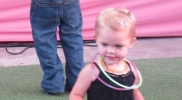
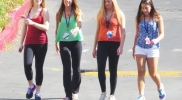

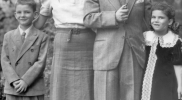
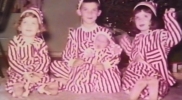

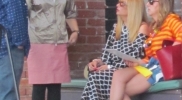
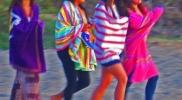

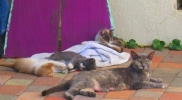

![[000015] [000015]](https://beforetheblog.com/wp-content/gallery/kids/thumbs/thumbs_000015.jpg)


